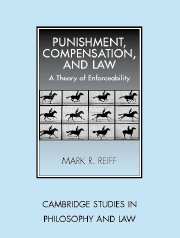Book contents
- Frontmatter
- Contents
- Acknowledgments
- Introduction
- 1 The Means of Enforcement
- 2 The Goals of Enforcement
- 3 Measuring Enforceability in the Previolation State of Affairs
- 4 Measuring Enforceability in the Postviolation State of Affairs
- 5 The Relationship between Previolation Expectations and Postviolation Practice
- 6 Limitations on the Means of Enforcement
- 7 Special Problems with Legal Remedies
- 8 The Value of Nominal Rights
- References
- Index
- Titles in the series
4 - Measuring Enforceability in the Postviolation State of Affairs
Published online by Cambridge University Press: 15 August 2009
- Frontmatter
- Contents
- Acknowledgments
- Introduction
- 1 The Means of Enforcement
- 2 The Goals of Enforcement
- 3 Measuring Enforceability in the Previolation State of Affairs
- 4 Measuring Enforceability in the Postviolation State of Affairs
- 5 The Relationship between Previolation Expectations and Postviolation Practice
- 6 Limitations on the Means of Enforcement
- 7 Special Problems with Legal Remedies
- 8 The Value of Nominal Rights
- References
- Index
- Titles in the series
Summary
Having articulated a test for determining whether the available measure of punishment is sufficient to render a right enforceable before it has been violated, and an alternative test for determining whether the available measure of compensation is sufficient to render a right enforceable before it has been violated, we must now look at whether these same or some different tests should apply when determining whether a right is enforceable after it has been violated. Recall that in the previolation state of affairs, we wanted to know whether the measure of enforcement available was such that the beneficiary would be willing to incur the risk of violation or, if incurring that risk were unavoidable, whether the beneficiary would be able to experience the risk without feeling unduly threatened and without feeling compelled to adopt elaborate precautionary measures. The amount of punishment available would be sufficient to satisfy this requirement, we decided, if the beneficiary rationally believed that it was enough to make potential violators prefer to remain in the previolation state of affairs. Alternatively, the amount of compensation would be sufficient if the beneficiary rationally believed that it was enough to make her indifferent to any violation that might occur. Our rationale for the sufficiency of punishment test, which we saw was the one most likely to be satisfied in the vast majority of cases, was that a potential violator who preferred to remain in the previolation state of affairs would be unlikely to violate the beneficiary's rights intentionally, and while she might commit an unintentional violation, she would at least have an incentive to take precautions against such violations to the extent this was rational and within her ability to do so.
- Type
- Chapter
- Information
- Punishment, Compensation, and LawA Theory of Enforceability, pp. 111 - 174Publisher: Cambridge University PressPrint publication year: 2005

